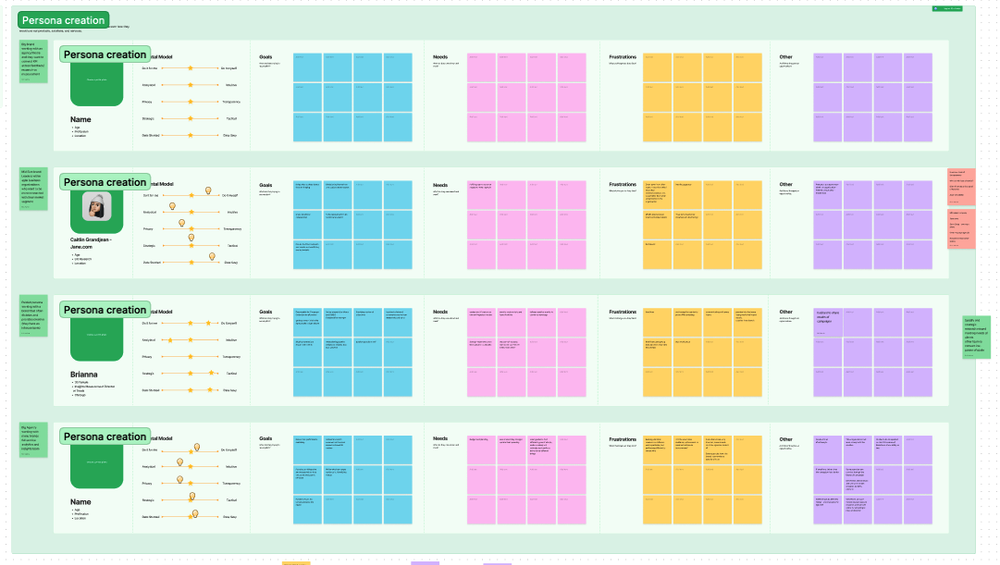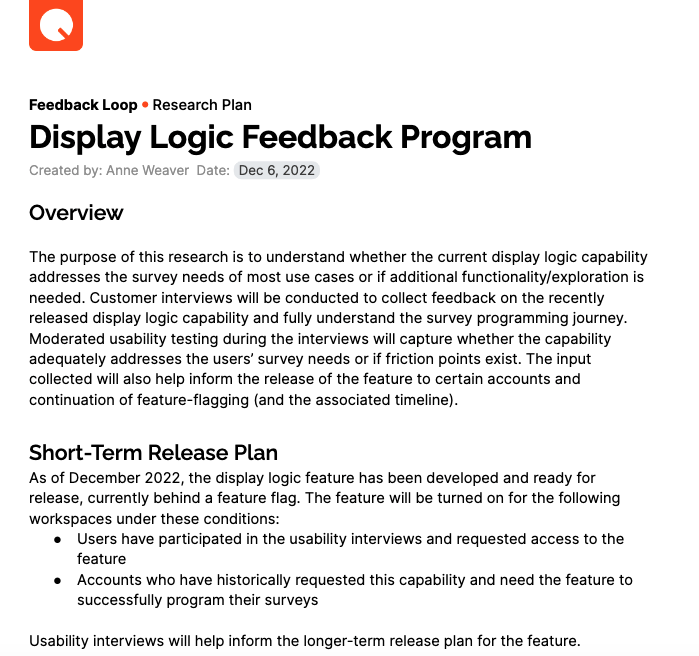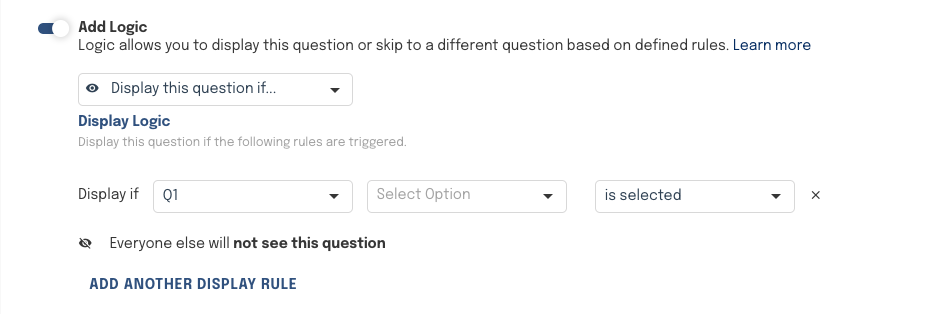Sample Projects
Survey Research: Snapshots Program (SEPA)
Persona Development: Enterprise Users (DISQO)
Usability Testing: Survey Logic (Feedback Loop)
Evaluative Mixed-Method Research: EV Program Optimization (Opinion Dynamics)
In-Depth Interviewing: Municipal Clean Energy Program Evaluation (Research into Action)
SEPA Snapshots
Company: Smart Electric Power Alliance (SEPA) | Year: 2023 - 2024 | Role: Senior Manager, Market Intelligence
Overview
I led SEPA's 2024 “Snapshots” program, a comprehensive research initiative to provide insights into the clean energy sector for internal stakeholders and more broadly for SEPA members. This project encompassed six key focus areas: resilience, transportation, emerging technology, policy, energy storage, and energy equity. I gathered quantitative and qualitative data from utility representatives and industry participants through online surveys and secondary research. My role involved survey design, project strategy & management, cross-team collaboration, data analysis, and synthesis. The findings were disseminated through summary reports, conference presentations, organizational talking points, and infographics, facilitating industry-wide knowledge sharing and benchmarking. This initiative empowered utilities and policymakers to make informed decisions, driving innovation, market adoption, and reinforcing SEPA's position as a thought leader in the energy sector.
Objectives
The purpose of the Snapshots program was to:
Provide timely & actionable insights: deliver primary, data-driven findings to help industry stakeholders navigate the evolving clean energy landscape.
Benchmark industry trends: track annual progress across SEPA’s six focus areas: resilience, transportation, emerging technology, policy, energy storage, and energy equity.
Inform decision-making: equip utilities, policymakers, and other key energy industry leaders with the knowledge needed to drive effective clean energy strategies and policies.
Facilitate industry collaboration: encourage cross-sector dialogue and partnerships to accelerate decarbonization and innovation.
Strengthen SEPA’s thought leadership: reinforce SEPA’s role as a trusted source of market intelligence in the clean energy transition.
Approach
The program employed a mixed-methods research approach, combining quantitative surveys, qualitative insights, and secondary research to analyze industry trends. Data was collected via two online surveys (targeting utilities and industry professionals), with a structured, module-based survey design tailored to SEPA’s focus areas and different organization types. Sampling leveraged SEPA’s databases and D&B Hoovers, with recruitment via email campaigns, social media, word-of-mouth, and industry outreach. Data collection & analysis utilized tools like Qualtrics, Salesforce, and Excel. Several hundred unique organizations and corresponding representatives responded to the surveys & provided insights on resilience, transportation, emerging tech, policy, energy storage, and equity, ensuring a comprehensive, data-driven view of the evolving energy landscape.
Learnings & Impact
The Snapshots program aims to actively drive change by facilitating industry alignment, accelerating technology adoption, and shaping policy decisions that support a cleaner, more resilient grid. By providing accessible data-driven insights, the program now helps utilities, policymakers, and stakeholders align on best practices, integrate emerging technologies like AI and Virtual Power Plants, and develop regulatory frameworks that enable decarbonization. Additionally, the program fosters cross-sector collaboration, strengthening partnerships between utilities, businesses, and technology providers to drive shared innovation and investment, creating a feedback loop among these audiences that didn’t exist before. Ultimately, Snapshots served as a baseline & catalyst for action, equipping stakeholders with the insights needed to make more informed, strategic decisions that accelerate the clean energy transition.
At a glance, these are some of the learnings from the survey research, structured by focus area:
Resilience: many utilities enhance their grid resilience by integrating microgrids and behind-the-meter resources, leading to more adaptable and reliable energy systems.
Transportation: collaborative efforts between utilities and businesses are accelerating electric vehicle adoption, addressing infrastructure challenges, affordability, and public awareness to create a cleaner transportation network.
Emerging Technology: stakeholders are leveraging technologies like artificial intelligence, distributed energy resource management systems (DERMS), and virtual power plants (VPPs) to advance decarbonization, despite regulatory and market adoption challenges.
Energy Storage: deploying energy storage solutions is enhancing grid stability and reliability, facilitating the integration of renewable energy sources and supporting a more resilient energy infrastructure.
Policy: supportive policies are laying the groundwork for progress in the clean energy transition, enabling the integration of carbon-free energy while maintaining affordability, safety, and reliability.
Energy Equity: efforts are underway to ensure that the benefits of the clean energy transition are accessible to all communities, promoting inclusivity and addressing historical disparities in energy access and affordability.
DISQO’s User Personas
Company: DISQO | Year: 2023 | Role: UX Researcher
Overview
I developed user personas for DISQO’s enterprise side, focusing on the survey platform (“Experience Suite”), Ad Testing, and Ad Measurement products. These personas captured core user groups: their needs, pain points, responsibilities, and how they engage with DISQO’s products. The work helped our design and product teams answer, “Who are we designing for?”
For Ad Testing, personas clarified user support needs, the value of test templates, and preferences for features like benchmarking and statistical testing.
Rooted in qualitative research and web analytics, the personas also informed decisions on standardization vs. customization of surveys and tests. The final personas were documented and shared across teams via detailed reports in our UXR repository and reporting tool, Condens.
Objectives
The goals of the personas were to:
User understanding: better understand DISQO’s core user groups.
Empathy and user-centric design: develop deeper empathy towards DISQO’s customers and guide design decisions that are centered on the user's needs and preferences. Design decisions related to Experience Suite— specifically the survey “builder” elements, survey templates, audience & sample experiences, and reporting & data visualizations.
Feature development: uncover features and functionalities that are relevant and useful to each user group.
Priority users: identify which user groups have the most growth potential within DISQO: the types of users who are most likely to use all of DISQO’s enterprise products.
Guidance and support: determine the types of guidance, support, onboarding, and templates different users require at various stages of their research and surveying journey within DISQO's products.
Direction for development: provide clear answers to the design and product teams on who they are designing for, aligning efforts towards a common goal.
Approach
My approach to this foundational research project was a structured blend of qualitative and quantitative methods to develop a deeper understanding of DISQO users. I created a participant CRM to manage participant data across trial users, prospects, and current customers. I identified key themes and patterns by analyzing existing customer interview data using qualitative coding in Condens.
To ensure consistency, I integrated standardized persona-building questions into all customer interviews and conducted generative research to explore users’ jobs and responsibilities. I complemented these insights with behavioral data from Pendo, categorizing users based on usage levels and roles. A stakeholder workshop provided an opportunity to refine and validate these personas, resulting in nine comprehensive user persona reports. These reports captured a holistic view of users, including their roles, mental models, goals, research practices, challenges, and support needs, alongside a quantitative data appendix.
Learnings & Impact
Outlined below are some of the results and impacts of the persona project:
Validated, documented, and solidified our understanding of the types of people who use DISQO’s products (and which ones)
Updated and replaced outdated existing personas that were buried and unused by teams
Increased collaboration with new teams and stakeholders (e.g., marketing) to coordinate user vs. buyer personas
Identification of prioritized user types (AKA users from publisher companies) that helped inform organizational direction and product roadmap
Tactically identified the level of support and services different types of users need (i.e., collaboration with customer success, types of templates) via persona reports in addition to a supplementary “template” report.
Shifted the product & design teams’ ethos to designing features more specific to target user types (vs. not generally thinking about our personas)
Feedback Loop Survey Logic Usability
Company: Feedback Loop | Year: 2022 - 2023 | Role: UX Researcher
Overview
This research focused on improving the usability of survey logic within DISQO’s survey platform, Experience Suite (formerly Feedback Loop), through three key phases.
In Phase 1, I investigated the frequent misuse and confusion around skip logic, gathering user feedback through interviews to improve its usability and inform the survey builder roadmap.
In Phase 2, I evaluated the newly introduced display logic—a feature requested in Phase 1. Through customer interviews and moderated usability testing, I explored users' mental models, programming workflows, and whether the feature met their needs.
In Phase 3, I ran internal usability tests on an updated logic design, refining elements like multi-select logic rules, terminology, and application of both skip and display logic. Using Maze, I tested these updates to ensure clarity and ease of use.
Objectives
Phase 1: evaluate skip logic feature
The goal was to collect feedback on skip logic experiences & issues from internal and external users to improve the feature’s usability and discoverability. We wanted to leverage these insights to inform future development of survey logic and other needed improvements.
Phase 2: evaluate display logic feature & explore users’ survey & logic mental models
Understand if the new display logic feature met users' needs and identify areas needing improvement. Additionally, we wanted to investigate the process of survey programming and the role of logic while also evaluating user understanding of skip and display logic terms and their significance.
Phase 3: internally test updated skip & display logic designs
Internally test and improve the usability of an updated survey logic design (built based on user feedback provided in Phases 1 & 2). Ensure clarity in logic rules, terminology, and application of skip and display logic.
What is logic?
In surveys, logic defines rules that adjust questions based on responses, creating a dynamic survey experience.
Skip Logic skips irrelevant questions based on answers. Display Logic shows only relevant questions based on prior responses.
Feedback Loop previously handled logic on the backend. In 2022, we launched a user-facing platform with skip logic, later expanding and adjusting based on my user research.
Approach
My research approach consisted of three phases. Phase 1 involved five 30-minute moderated usability interviews evaluating skip logic functionality, with insights synthesized using FigJam. Phase 2 expanded to five 45-minute customer interviews, exploring survey programming logic and testing the usability of the new display logic feature, with findings presented to key stakeholders. Phase 3 was an internal unmoderated usability test in Maze, where 10 participants completed survey tasks while sharing their screen, leading to a final synthesis of insights shared with design, product, engineering, and customer success teams.
Learnings & Impact
My Phase 1 insights revealed significant user confusion around skip logic, emphasizing the need for clearer guidance and educational resources. Users’ varying mental models and terminology highlighted the importance of tailored support. The complexity of survey logic, particularly multi-select conditions, created cognitive challenges, while unclear terminology and lack of visual management further hindered usability.
The team implemented design improvements based on my research insights, including visual indicators and enhanced instructions, also leading to a shift from skip to display logic, better aligned with users’ mental models. Tracking in Pendo confirmed increased feature adoption, directly validating research findings. Improved usability reduced cognitive load, boosting engagement and self-serve platform adoption. Additionally, enhanced user education through onboarding guides and in-platform explanations minimized errors and reliance on customer support.
Ultimately, this research drove iterative product development, refining survey logic functionality and improving the overall user experience for programming surveys.
“I’m really used to the display logic feature at this point. I think it’s 10x easier to use than skip logic. The brain capacity to try to figure it out... I know that skip logic has been pretty difficult for some people. I think display logic is a huge improvement from that.”
Opinion Dynamics EV Program Optimization
Company: Opinion Dynamics | Year: 2018 - 2020 | Role: Senior Consultant
Overview
For this research project, I did the following:
Assessed the process of siting, designing, and installing electric vehicle (EV) chargers to inform future program expansion for a local utility EV pilot program.
Surveyed local residents and EV owners to understand charging infrastructure’s impact on purchasing behavior and EV sales.
Conducted online surveys, in-person intercept surveys, and in-depth interviews with utility program staff and partners.
Delivered recommendations to the utility that improved the program’s effectiveness, increased EV adoption, and led to cost savings for EV owners.
Objectives
The study aimed to assess the pilot program’s successes and challenges, provide recommendations for future expansion, and measure its impact on EV awareness, sales, and usage. It also explored how customers used the charging stations in different conditions and how the infrastructure influenced EV sales and driver behavior.
Learnings & Impact
Deploying new EV charging infrastructure had a range of effects on local drivers. Awareness of the charging sites increased significantly from 2018 to 2019, particularly among rideshare drivers (Lyft and Uber), who emerged as the primary users. Charger utilization varied by location, with sites closer to central hubs, such as the airport, seeing higher usage. Over time, as more sites were introduced and awareness grew, utilization rates steadily increased. Additionally, site opening events in 2019, supported by strong marketing efforts, successfully attracted attendees and influenced their likelihood of purchasing or leasing an EV, especially among TNC drivers.
The process of deploying new charging infrastructure highlighted both challenges and successes. As an emerging technology, EV chargers faced software and hardware issues, underscoring the need for a structured protocol for maintenance and operations. Strong customer support was essential in minimizing charger downtime and ensuring a positive user experience. Site design and installation required a collaborative approach between program administrators, contractors, and site hosts, as each location presented unique challenges. Partnering with municipal governments proved crucial, as they aligned with the program’s sustainability goals and provided valuable outreach resources. The permitting process, however, was found to be relatively smooth due to close coordination between the utility and local planning departments.
The program also faced operational hurdles, particularly with its charging hardware vendor, whose technology had reliability issues. Based on my findings, I recommended exploring alternative vendors to reduce downtime and improve site functionality. The COVID-19 pandemic further impacted charger utilization and awareness in 2020, prompting a reassessment of utilization goals for future years. To enhance site performance and user experience, I advised prioritizing charger maintenance by allocating additional resources and staff to better manage operations and minimize disruptions. These recommendations aimed to improve the long-term success of the EV charging initiative and support broader EV adoption efforts.
Approach
Online surveys with local residents, including those who drive EVs and those who do not. Survey questions pertained to awareness and utilization of local EV charging sites and likelihood to purchase an EV in the future, among other demographic topics.
In-person intercept surveys with attendees of an EV charging site opening. I attended the ribbon-cutting ceremony of a new EV charging site, where attendees could test drive EVs. I surveyed the attendees to explore their motivations of attending the event, source of awareness, and interest in purchasing an EV after attending the event.
In-depth 1:1 interviews with program staff, site hosts, and charging equipment vendors. To collect information on the full process of designing and installing an EV charging site for the pilot program, I conducted roughly 10 interviews with program managers, hosts (public and private) of the site location, and equipment vendors.
Municipal Clean Energy Program Evaluation
Company: Research into Action | Year: 2018 - 2019 | Role: Consultant
Overvew
I helped evaluate a statewide clean energy program that aimed to improve community access to tools, resources, and grants for implementation of clean energy projects. The goal was to gather detailed qualitative and quantitative data to measure the program's impacts, costs, and barriers.
Insights were later developed from this data to produce recommendations on improving the program design and help the program administrator increase program participation.
Objectives
Establish a baseline understanding of the number of participants in the program, explore the barriers of participating in the program and moving forward with energy-related projects, and assess the direct and indirect impacts of the program on uptake of clean energy activities across the state.
Approach
To measure the program’s direct and indirect costs and impacts, but also fully understand the barriers and areas of improvement, I needed to collect both quantitative and qualitative data.
Web & phone surveys with participating and non-participating communities, as well as program coordinators, to gather data on clean energy projects completed, costs to implement such projects, barriers and resources needed to implement activities, and satisfaction with the program, among other measurable topics.
In-depth 1:1 interviews with dozens of highly-engaged communities to thoroughly understand the direct and indirect impacts of the program on participating communities.
In-depth group interviews with 3 communities to develop case studies on specific clean energy projects. Projects included a community-based solar group-purchasing program and a state-sponsored greenhouse gas mitigation program.
“Ever since the start of the program and our work with our coordinator, we have seen an increased trust across the whole municipal government in clean energy and our steps in becoming more efficient”
Learnings & Impact
My research found that the program has significantly advanced clean energy adoption by providing communities with a clear framework to take on new projects, leading to sustained interest in solar energy and inspiring neighboring municipalities to follow suit. Grant-funded communities have expanded their staff to drive further sustainability efforts. However, awareness of the program remained low among non-participating communities, and political barriers hinder progress in some areas. Additionally, the program lacks ongoing incentives for communities that have completed initial milestones, and its current activities do not always align with the needs of all community types.










